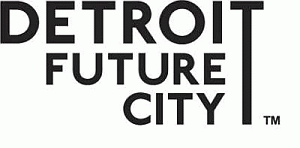Detroit Works Long-Term Planning Project: Engagement Strategies for Blending Community and Technical Expertise
Abstract
:1. Introduction
- Recognize the profound challenges that culture, race, and politics can present to a civic engagement process. Address these challenges through a deliberate strategy of building trust and enthusiasm with and within the community;
- Elevate community expertise by fostering a sense of ownership of the process among local civic leaders, as well as adopting an expansive view of community that includes the perspectives not only of residents, but also of multiple sectors and segments of the community;
- Create an intentional approach for blending technical and community expertise on a citywide scale. Acknowledge experiential and anecdotal inputs as valid, and integrate them with technical research and analysis to create a more accurate and inclusive case for change and implementation;
- View civic engagement as an ongoing two-way conversation rather than a series of large-scale episodic events. Provide a wide range of opportunities and methods for people to interact with, learn about, provide feedback to, and in other ways shape the resulting plan.
2. Project Overview
2.1. Origins of the Strategic Planning Process and Key Players
2.2. Engagement Tactics for the Strategic Planning Process
2.2.1. In-Person Engagement Tactics
- Large-scale town hall meetings (community learning);
- Topic-based summits (gathering input, community learning/dialogue, and idea generation);
- Community conversations (gathering input, building trust, and community learning/dialogue);
- The “Roaming Table” (building trust);
- Open houses and drop-in visits to the project’s Home Base office (gathering input, building trust, and community learning/dialogue);
- Attending or presenting at existing community meetings (gathering input and community learning/dialogue);
- Street team door-knocking and leafleting (building trust);
- Technical team working sessions (synthesizing input).
2.2.2. Virtual Engagement Tactics (Including both Online and Phone)
- Telephone town halls (building trust and community learning);
- “Detroit 24/7” online planning game (gathering input, idea generation, and community learning/dialogue);
- E-newsletters (building trust and community learning);
- Home Base “hotline” calls (community learning);
- Website updates and social media (building trust and community learning);
- “Detroit Stories” video history project (building trust and community learning/dialogue);
- Earned media, such as print, radio, and television media and communications features (building trust and community learning).
2.3. References for This Case Study Analysis
3. Results and Discussion
3.1. Setting the Stage
3.2. Process and Strategies
3.2.1. Strategy #1: Overcoming the Challenges of Culture, Race, and Politics
3.2.2. Strategy #2: Designing a Process that Elevates Community Expertise
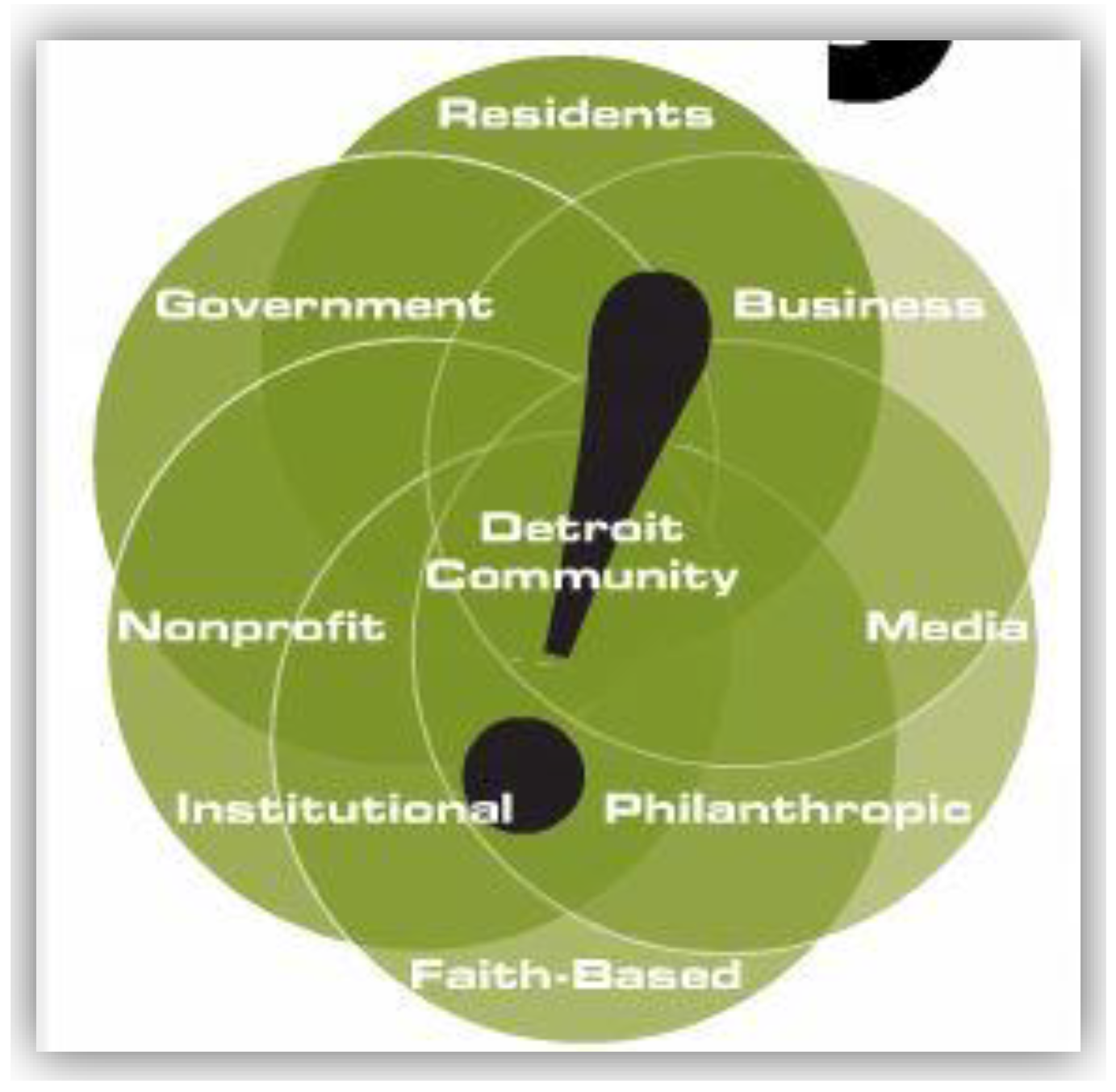
Examples of Community “Fingerprints” in DWPLTP
- √
- Reduce blight by making properties cleaner and safer;
- √
- Encourage people to stay in Detroit, contribute to community, be neighborly, and maintain property;
- √
- Get together with a group of neighbors and fellow citizens as a way of improving the neighborhood;
- √
- Encourage community-based and youth-focused programs to improve safety in moderate vacancy areas.
3.2.3. Strategy #3: Creating an Intentional Approach for Blending Technical and Community Expertise at a Citywide Scale

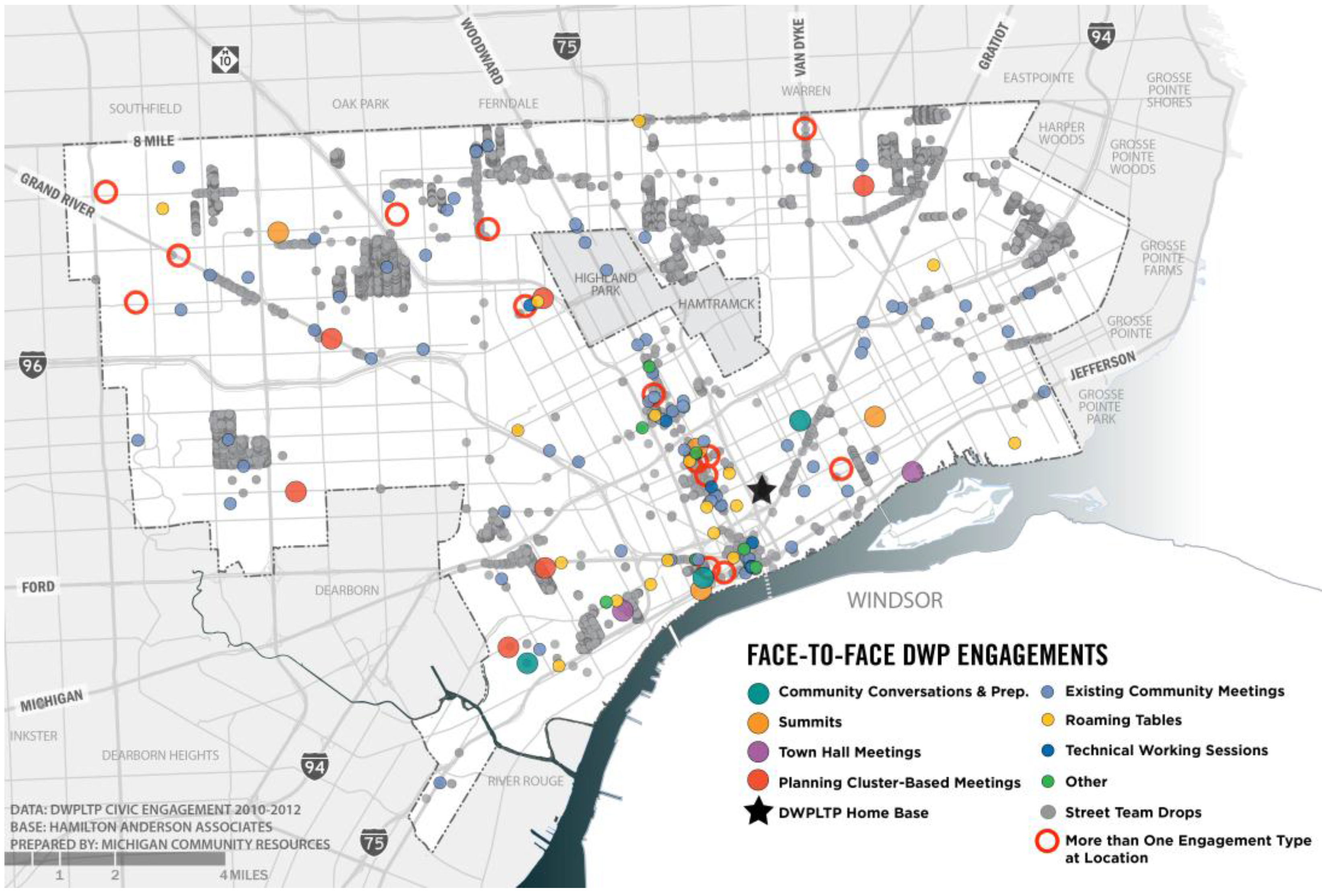
12 Imperative Actions
- We must re-energize Detroit’s economy to increase job opportunities within the city for Detroiters and strengthen the tax base;
- We must support our current residents and attract new residents;
- We must use innovative approaches to transform our vacant land in ways that increase its value and productivity and promote long-term sustainability;
- We must use our open space to improve the health of all Detroit’s residents;
- We must promote a range of sustainable residential densities;
- We must focus on sizing the networks for a smaller population, making them more efficient, more affordable, and better performing;
- We must realign city systems in ways that promote areas of economic potential, encourage thriving communities, and improve environmental and human health conditions;
- We must be strategic and coordinated in our use of land;
- We must promote stewardship for all areas of the city by implementing short- and long-term strategies;
- We must provide residents with meaningful ways to make change in their communities and the city at large;
- We must pursue a collaborative regional agenda that recognizes Detroit’s strengths and our region’s shared destiny;
- We must dedicate ourselves to implementing this framework for our future.
3.2.4. Strategy #4: Viewing Civic Engagement as an Ongoing Two-Way Conversation Rather Than a Series of Large-Scale Episodic Events
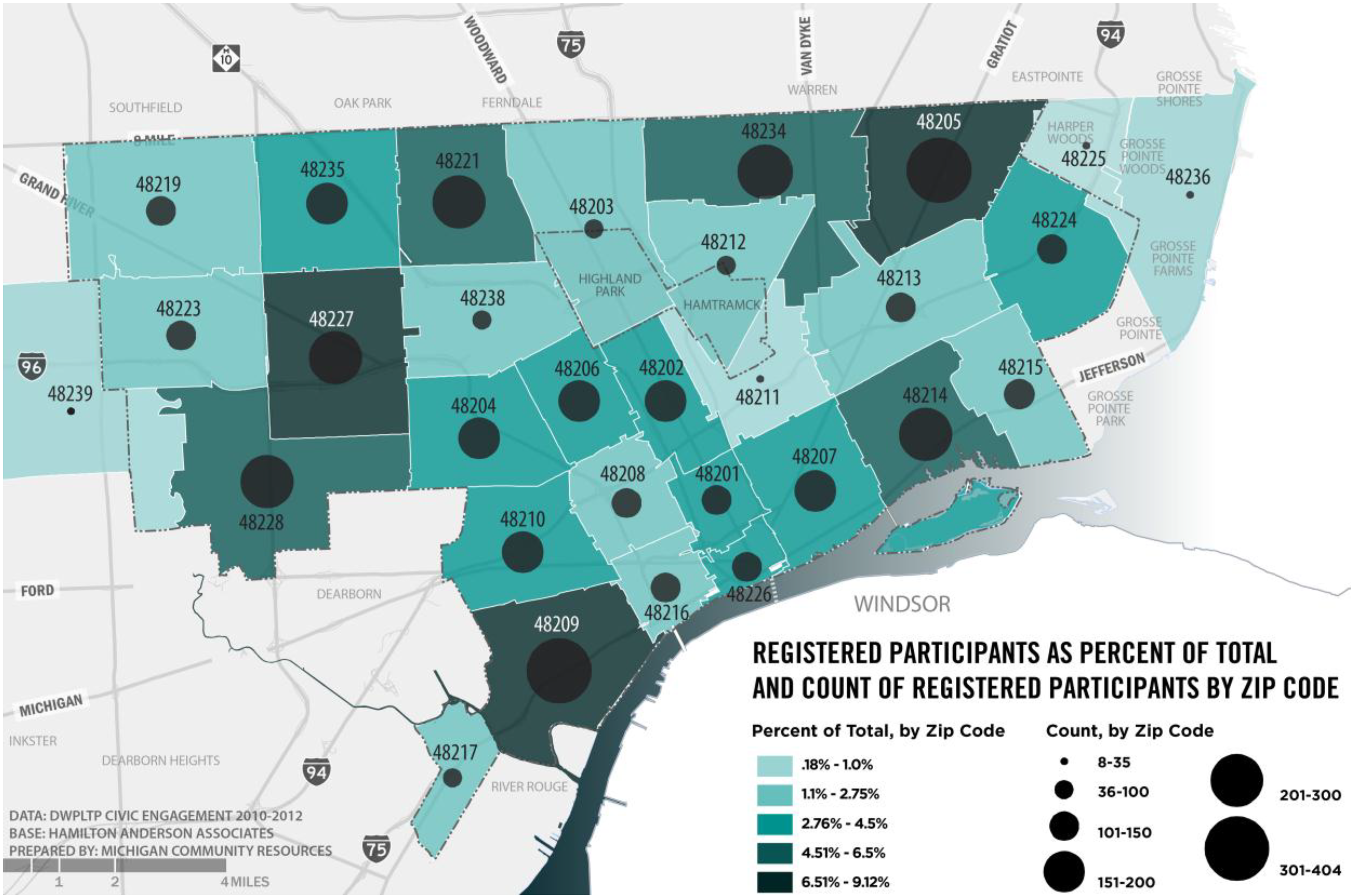
- One of the tactics that helped to facilitate two-way conversation and learning was the “Roaming Table”, a small travelling conversation booth that was staffed and stationed at various community locations. Tabling at events and meetings is a common engagement tactic for many efforts. However, the Roaming Table was unique because it could be set up anywhere rather than reaching only event attendees. And rather than being staffed by a project volunteer sitting passively behind a table full of flyers and materials it was designed to be approachable and interactive. The booth was designed inexpensively and could be collapsed to fit into the trunk of a car, so that organizers could transport it easily from place to place. The Roaming Table was ideal for engaging people in brief, one-on-one interactions about DWPLTP as they walked by, both to expose new people to the project as well as to solicit input on a specific planning question. This tactic facilitated more than 600 one-on-one conversations about the project (See Figure 5);
- The project also hosted a series of hour-long telephone town hall events, which reached more than 6000 people and engaged approximately 1300 participants. These were distinct from the five town hall meetings held at the beginning of the project, which were face-to-face facilitated exchanges between technical experts and a larger than expected crowd of participants. A telephone town hall, by contrast, is a virtual meeting that takes place via phone and can be joined from any telephone, such as from the convenience of a person’s home. It is a cost-effective and accessible technique for those for whom face-to-face meetings are challenging or unappealing. The technology uses an auto-dialer to call a specified list of phone numbers, offering a way to reach a large group of people instantly. People can listen to a speaker or a panel, ask questions in real time, or record messages expressing their perspectives on an issue. The telephone town halls promoted the two-way conversation between the speakers and the callers. These virtual town hall meetings allowed callers to hear project updates from Detroit community leaders, and to join the conversation live by posing their questions and comments. This tactic was particularly effective in engaging those who did not have the interest or ability to attend an in-person meeting, such as those with limited accessibility or who worked at times when community meetings took place. Many seniors participated in the telephone town halls.
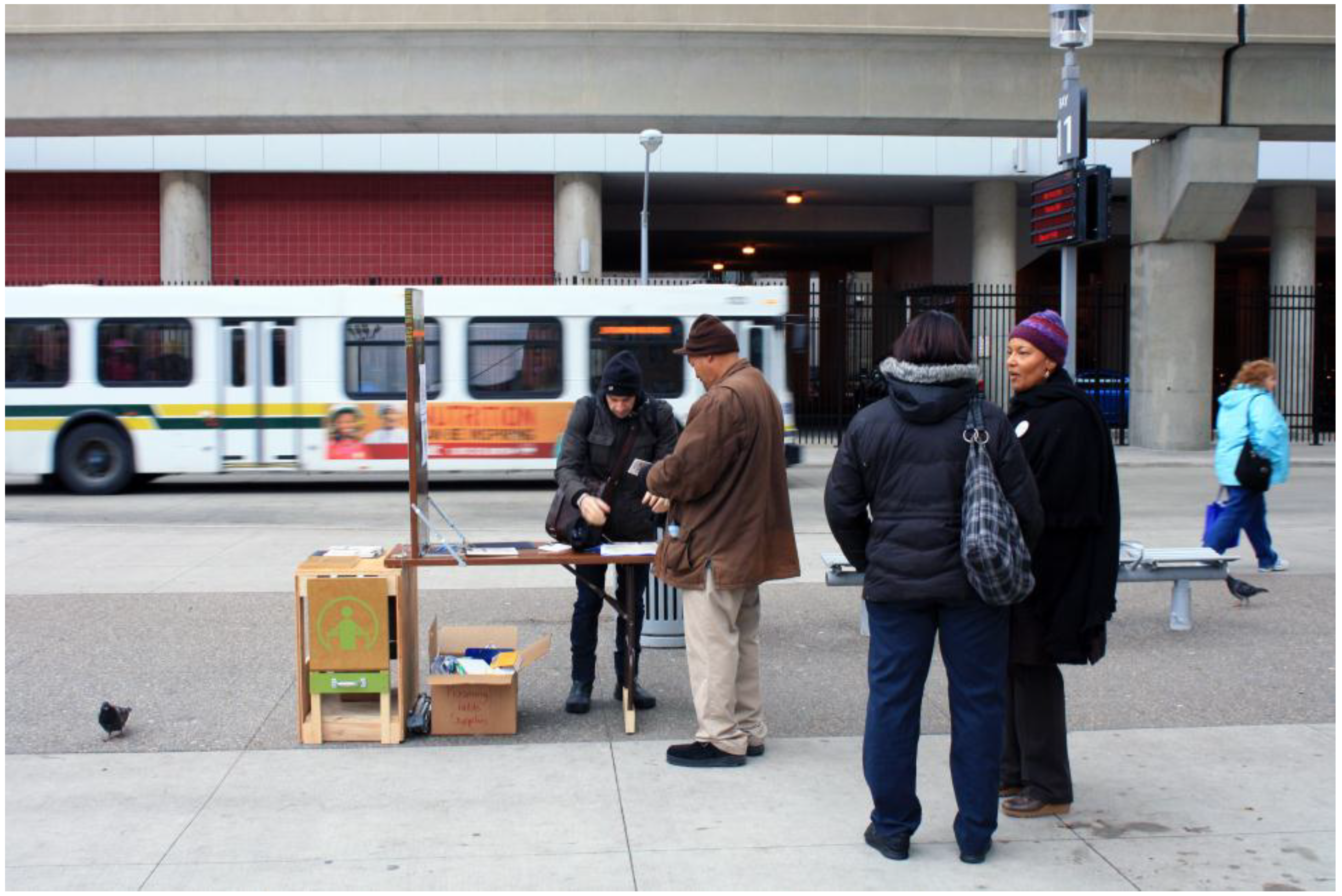

4. Conclusions

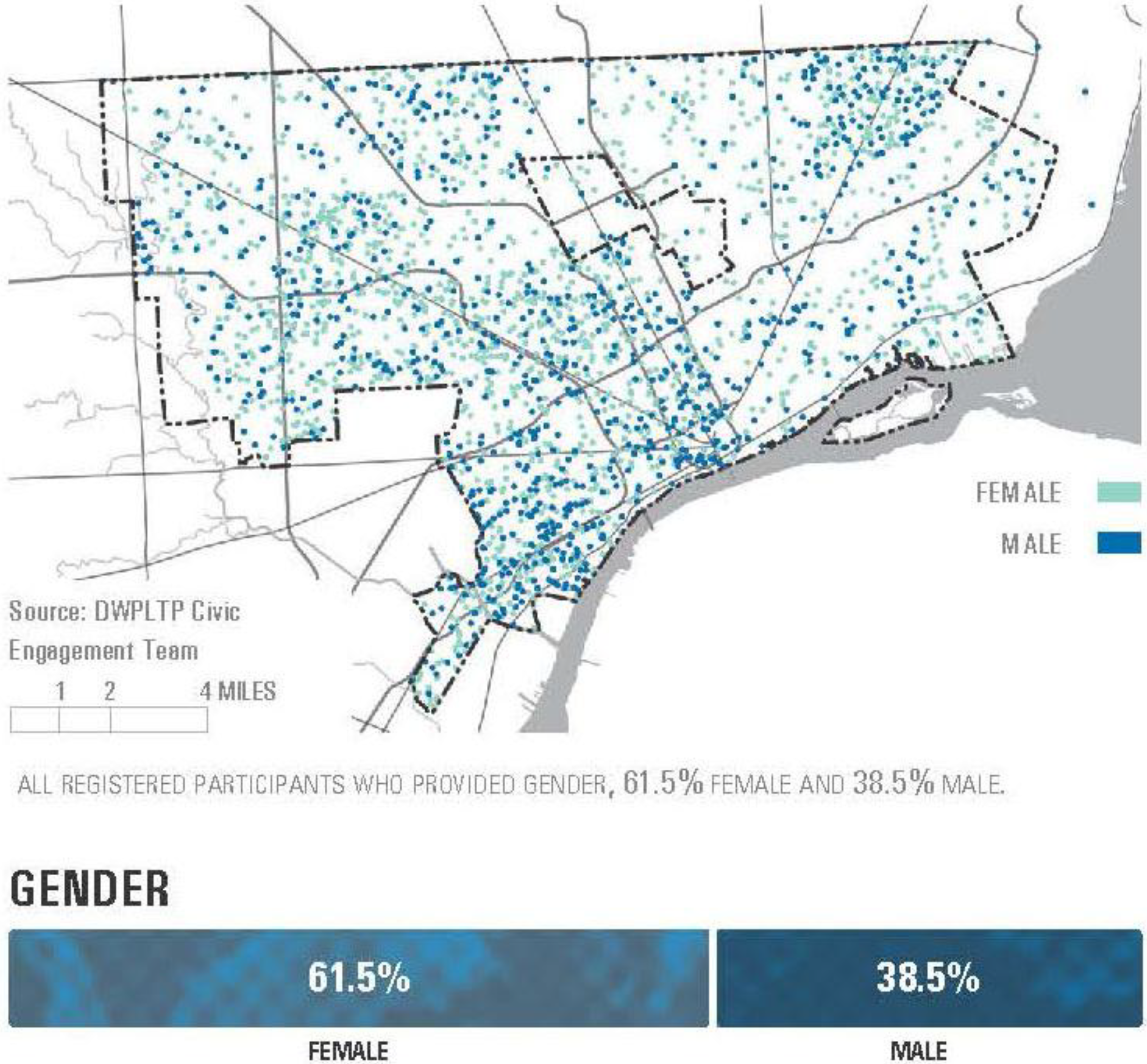
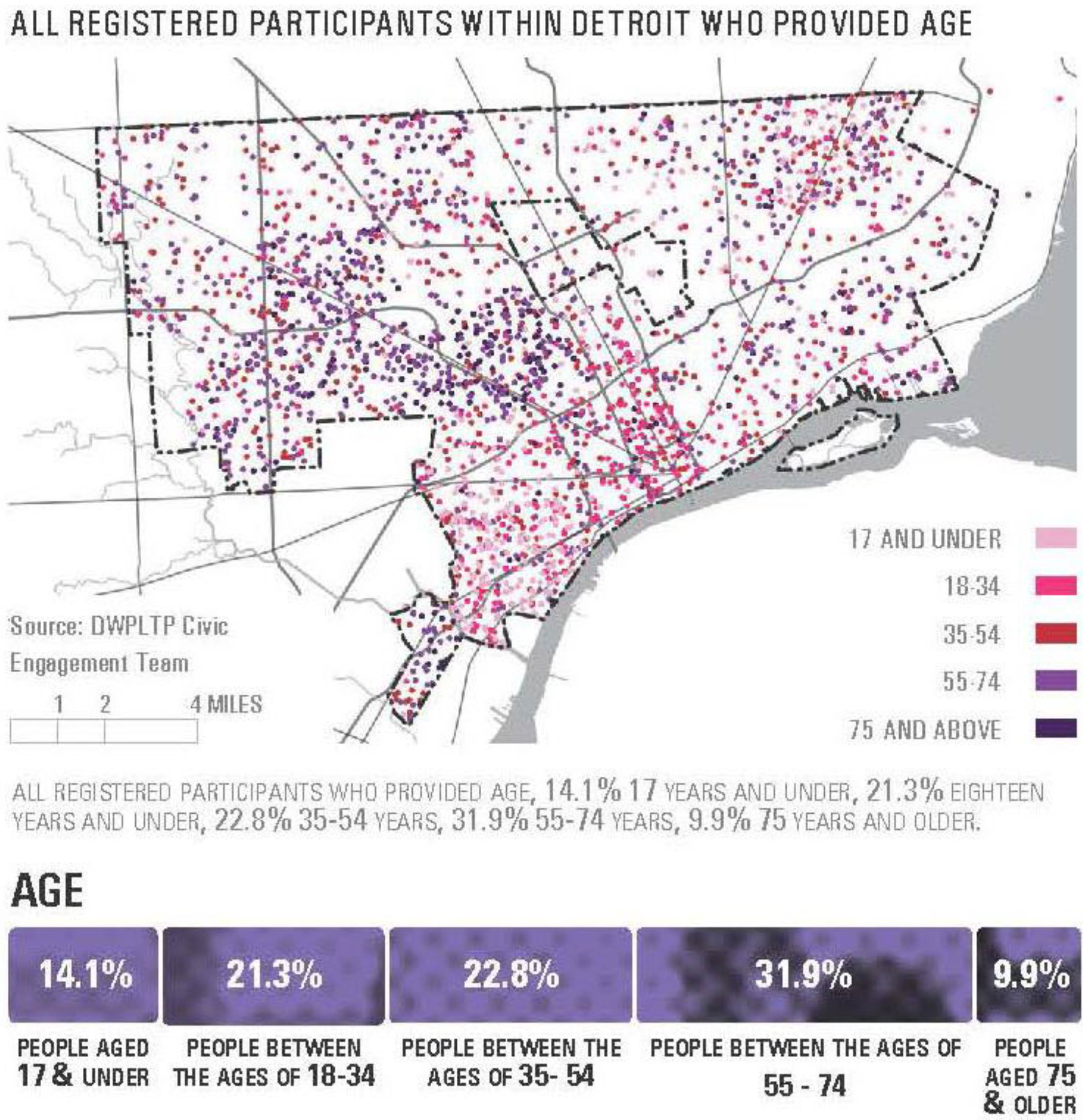
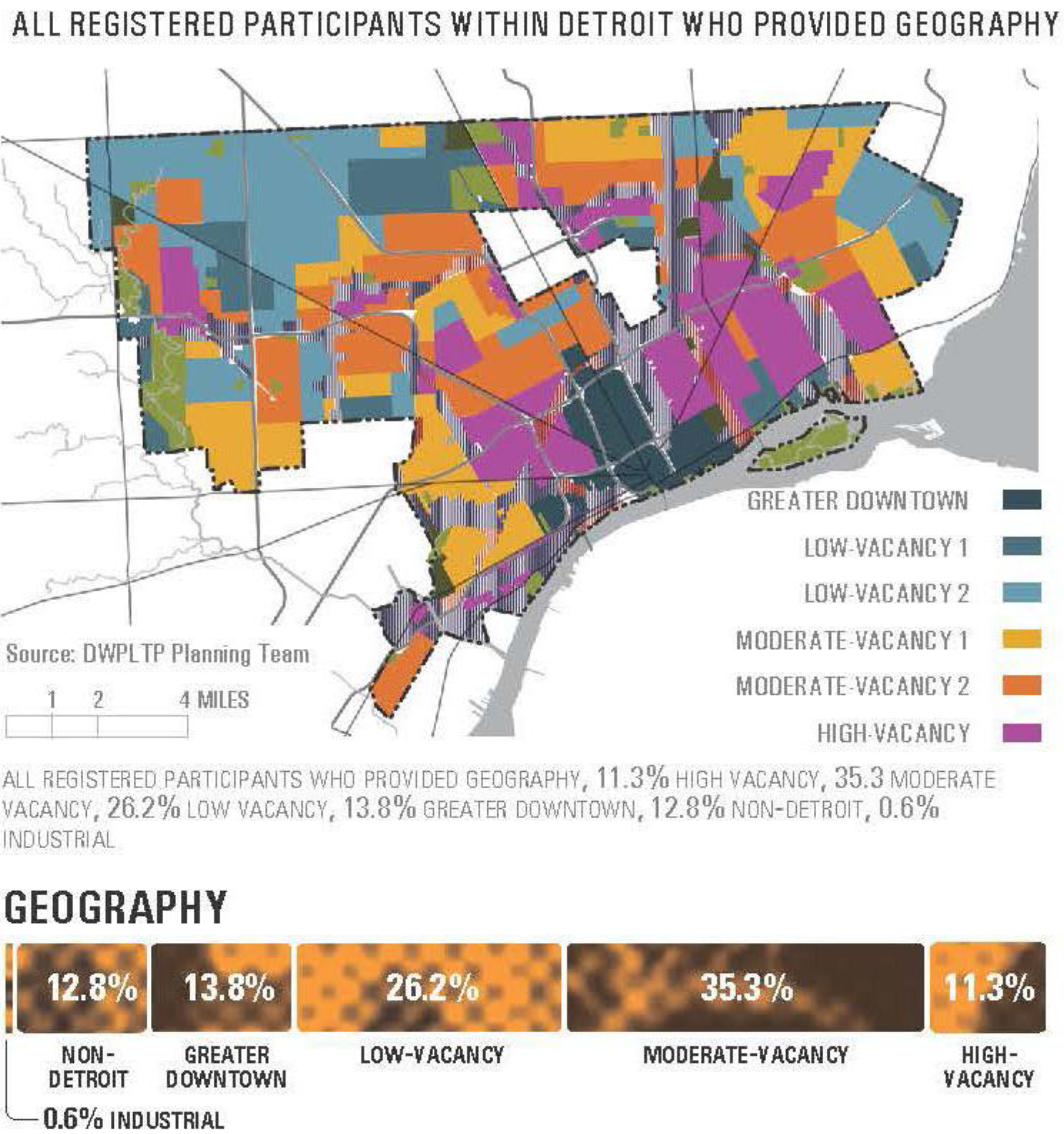
Acknowledgments
Authors Contribution
Conflicts of Interest
References
- Leighninger, M. Creating Spaces for Change: Working Towards a “Story of Now” in Civic Engagement; Deliberative Democracy Consortium and W.K. Kellogg Foundation: Battle Creek, MI, USA, 2010. [Google Scholar]
- Pastor, M.; Ito, J.; Rosner, R. Transactions, Transformations, Translations: Metrics That Matter for Building, Scaling, and Funding Social Movements; USC Program for Environmental and Regional Equity (PERE): Los Angeles, CA, USA, 2011. [Google Scholar]
- Powell, J.R.J.; Hardaway, P. Recommendations for Assuring Robust Civic Engagement & Equity in Detroit’s Shrinking City Planning Effort; Metropolitan Organizing Strategy Enabling Strength (MOSES) and The Kirwan Institute for the Study of Race and Ethnicity; Ohio State University: Columbus, OH, USA, 2010. [Google Scholar]
- Barnes, W.; Mann, B. Making Local Democracy Work: Municipal Officials’ Views about Public Engagement; Center for Research and Innovation, National League of Cities: Washington, DC, USA, 2010; pp. 13–18. [Google Scholar]
- Detroit Works Project: Long-Term Planning. Civic Engagement Appendix: Supporting Lasting Civic Capacity in Detroit; Detroit Economic Growth Corporation: Detroit, MI, USA, January 2013. Available online: http://detroitworksproject.com/wp-content/uploads/2013/01/05-Civic-Engagement.pdf (accessed on 31 January 2014).
- Cramer, C. Detroit Engagement Audit Report; Grassroots Solutions: Minneapolis, MN, USA, 2010. [Google Scholar]
- WCHB News Detroit. Mayor Dave Bing Gives State of the City Address. 24 March 2010. Available online: http://wchbnewsdetroit.newsone.com/246091/mayor-dave-bing-gives-state-of-the-city-address-full-text/ (accessed on 19 August 2014).
- Hoene, C.; Kingsley, C.; Leighninger, M. Bright Spots in Community Engagement: Case Studies of U.S. Communities Creating Greater Civic Participation from the Bottom Up; National League of Cities: Washington, DC, USA, 2013; pp. 8–9. [Google Scholar]
- Detroit Future City: 2012 Detroit Strategic Framework Plan; Project of Detroit Future City (DFC) Strategic Framework. DFC Implementation Office: Detroit, MI, USA, December 2012. Available online: http://detroitworksproject.com/wp-content/uploads/2013/01/The-DFC-Plan.pdf (accessed on 7 October 2013).
- Clark, A. Dave Bing’s Detroit. The American Prospect. 2 October 2013. Available online: http://prospect.org/article/dave-bing%E2%80%99s-detroit (accessed on 21 April 2014).
- Davey, M. The Odd Challenge for Detroit’s Planners. New York Times. 5 April 2011. Available online: http://www.nytimes.com/2011/04/06/us/06detroit.html?pagewanted=1&_r=2&sq=detroit&st=cse&scp=1 (accessed on 21 April 2014).
- Cramer, C. Detroit Engagement Audit Report; Grassroots Solutions: Minneapolis, MN, USA, 2010; p. 30. [Google Scholar]
- Cramer, C. Detroit Engagement Audit Report; Grassroots Solutions: Minneapolis, MN, USA, 2010; p. 51. [Google Scholar]
- Chavez, C.; Matsumura, E.; Bacon, D. Mo(vement) Town: Building Civic Engagement in the Detroit Region; Working Partnerships USA; Detroit Collaborative Design Center; the Ford Foundation: San Jose, CA, USA, 2011; pp. 6–10. [Google Scholar]
- Oakley, D.; Tsao, H. A new way of revitalizing distressed urban communities? assessing the impact of the federal empowerment zone program. J. Urban Aff. 2006, 28, 443–471. [Google Scholar] [CrossRef]
- Cramer, C. Detroit Engagement Audit Report; Grassroots Solutions: Minneapolis, MN, USA, 2010; pp. 13–15. [Google Scholar]
- State and County Quick Facts; U.S. Department of Commerce, United States Census Bureau: Allegany, NY, USA. Available online: http://quickfacts.census.gov/qfd/states/26/2622000.html (accessed on 7 January 2014).
- Cramer, C. Detroit Engagement Audit Report; Grassroots Solutions: Minneapolis, MN, USA, 2010; pp. 26–28. [Google Scholar]
- Ishem, L.H. Beyond Insiders and Outsides: Conceptualizing Multiple Dimensions of Community Development Stakeholders. In The Paradox of Urban Space; Sutton, S.E., Kemp, S.P., Eds.; Palgrave Macmillan: Hampshire, UK, 2011; p. 95. [Google Scholar]
- Manzo, L.C.; Perkins, D.D. Finding common ground: The importance of place attachment to community participation and planning. J. Plan. Lit. 2006, 20, 340. [Google Scholar] [CrossRef]
- Detroit Works Project: Long-Term Planning Project Website. Available online: http://www.detroitworksproject.com (accessed on 31 January 2014).
- Detroit Works Project: Long-Term Planning. Civic Engagement Appendix: Supporting Lasting Civic Capacity in Detroit; Detroit Economic Growth Corporation: Detroit, MI, USA, January 2013; p. 91. Available online: http://detroitworksproject.com/wp-content/uploads/2013/01/05-Civic-Engagement.pdf (accessed on 31 January 2014).
- City versus Suburb: A Longstanding Divide in Detroit. Weekend Edition Sunday, National Public Radio. 9 March 2014. Available online: http://www.npr.org/2014/03/09/287877060/city-versus-suburb-a-longstanding-divide-in-detroit (accessed on 21 April 2014).
- ARISE Detroit! Unites Groups across the City. The Kresge Foundation. 4 February 2014. Available online: http://kresge.org/news/news-extra/arise-detroit-unites-groups-acrosscity#sthash.28AyDIQ6.dpuf (accessed on 22 April 2014).
- Kemp, S.P.; Sutton, S.E. Integrating social science and design inquiry through interdisciplinary design charettes: An approach to participatory community problem solving. Am. J. Commun. Psychol. 2006, 38, 125–139. [Google Scholar] [CrossRef]
- Detroit Works Project: Long-Term Planning. Civic Engagement Appendix: Supporting Lasting Civic Capacity in Detroit; Detroit Economic Growth Corporation: Detroit, MI, USA, January 2013; p. 227. Available online: http://detroitworksproject.com/wp-content/uploads/2013/01/05-Civic-Engagement.pdf (accessed on 31 January 2014).
- Mugerauer, R.; Manzo, L. Environmental Dilemmas: Ethical Decision Making (Toposophia: Sustainability, Dwelling, Design); Lexington Books: Lanham, MD, USA, 2008; pp. 24–27. [Google Scholar]
- Detroit Works Project: Long-Term Planning. Civic Engagement Appendix: Supporting Lasting Civic Capacity in Detroit; Detroit Economic Growth Corporation: Detroit, MI, USA, January 2013; p. 49. Available online: http://detroitworksproject.com/wp-content/uploads/2013/01/05-Civic-Engagement.pdf (accessed on 31 January 2014).
- Detroit Works Project: Long-Term Planning. Civic Engagement Appendix: Supporting Lasting Civic Capacity in Detroit; Detroit Economic Growth Corporation: Detroit, MI, USA, January 2013; p. 175. Available online: http://detroitworksproject.com/wp-content/uploads/2013/01/05-Civic-Engagement.pdf (accessed on 31 January 2014).
- Detroit Works Project: Long-Term Planning. Civic Engagement Appendix: Supporting Lasting Civic Capacity in Detroit; Detroit Economic Growth Corporation: Detroit, MI, USA, January 2013; p. 145. Available online: http://detroitworksproject.com/wp-content/uploads/2013/01/05-Civic-Engagement.pdf (accessed on 31 January 2014).
- Lukensmeyer, C.; Goldman, J.; Brigham, S. A Town Meeting for the Twenty-First Century. In The Deliberative Democracy Handbook: Strategies for Effective Engagement in the 21st Century, 1st ed.; Gastil, J., Levine, P., Eds.; Jossey-Bass: San Francisco, CA, USA, 2005; pp. 154–163. [Google Scholar]
- Detroit Works Project: Long-Term Planning. Civic Engagement Appendix: Supporting Lasting Civic Capacity in Detroit; Detroit Economic Growth Corporation: Detroit, MI, USA, January 2013; p. 158. Available online: http://detroitworksproject.com/wp-content/uploads/2013/01/05-Civic-Engagement.pdf (accessed on 31 January 2014).
- Detroit Works Project: Long-Term Planning. Civic Engagement Appendix: Supporting Lasting Civic Capacity in Detroit; Detroit Economic Growth Corporation: Detroit, MI, USA, January 2013; p. 160. Available online: http://detroitworksproject.com/wp-content/uploads/2013/01/05-Civic-Engagement.pdf (accessed on 31 January 2014).
- Detroit 24/7 Online Game; Community PlanIt. Available online: http://detroitworksproject.com/engagement/detroit247 (accessed on 31 January 2014).
- Gordon, E.; Baldwin-Philippi, J. Playful civic learning: Enabling reflection and lateral trust in game-based public participation. Int. J. Commun. 2014, 8, 759–786. [Google Scholar]
- Detroit Stories Oral History Project Website. Available online: http://www.detroitstoriesproject.com (accessed on 31 January 2014).
- Creighton, J.L. The Public Participation Handbook: Making Better Decisions Through Citizen Involvement; Wiley: Jossey-Bass: San Francisco, CA, USA, 2005; pp. 85–179. [Google Scholar]
- Detroit Works Project: Long-Term Planning. Civic Engagement Appendix: Supporting Lasting Civic Capacity in Detroit; Detroit Economic Growth Corporation: Detroit, MI, USA, January 2013; pp. 322–333. Available online: http://detroitworksproject.com/wp-content/uploads/2013/01/05-Civic-Engagement.pdf (accessed on 31 January 2014).
- Turner-Handy, S. A Common Theme throughout the Detroit Future City Framework. Michigan Citizen. 28 March 2013. Available online: http://michigancitizen.com/urban-agriculture-as-a-tool-to-help-revitalize-the-city/ (accessed on 22 April 2014).
- Thompson, A.; Wheeler, H. Commentary: No Debate, Detroit Future City Is the People’s Plan. MLive. 3 April 2014. Available online: http://blog.mlive.com/news/detroit_impact/print.html?entry=/2014/04/commentary_no_debate_detroit_f.html. (accessed on 21 April 2014).
- Lorimer, J. Detroit Future City Is Full of Small Mistakes. HuffPost Detroit. 22 January 2013. Available online: http://www.huffingtonpost.com/jason-lorimer/full-of-small-mistakes_b_2517018.html (accessed on 5 May 2014).
© 2014 by the authors; licensee MDPI, Basel, Switzerland. This article is an open access article distributed under the terms and conditions of the Creative Commons Attribution license (http://creativecommons.org/licenses/by/4.0/).
Share and Cite
Griffin, T.L.; Cramer, D.; Powers, M. Detroit Works Long-Term Planning Project: Engagement Strategies for Blending Community and Technical Expertise. Buildings 2014, 4, 711-736. https://doi.org/10.3390/buildings4040711
Griffin TL, Cramer D, Powers M. Detroit Works Long-Term Planning Project: Engagement Strategies for Blending Community and Technical Expertise. Buildings. 2014; 4(4):711-736. https://doi.org/10.3390/buildings4040711
Chicago/Turabian StyleGriffin, Toni L., Dan Cramer, and Megan Powers. 2014. "Detroit Works Long-Term Planning Project: Engagement Strategies for Blending Community and Technical Expertise" Buildings 4, no. 4: 711-736. https://doi.org/10.3390/buildings4040711
APA StyleGriffin, T. L., Cramer, D., & Powers, M. (2014). Detroit Works Long-Term Planning Project: Engagement Strategies for Blending Community and Technical Expertise. Buildings, 4(4), 711-736. https://doi.org/10.3390/buildings4040711



